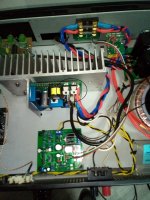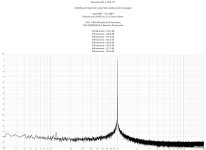Oops - yes you are right .. a mono amp.. my bad.How is that even remotely comparable? The B100 inductors carry identical signals in anti-phase.
I would avoid it anyways....
//
Interesting thread. Mostly many consumers don't really care about the technology so long as the product meets the needs. Products with 0.00000000% THD to 1% THD are equally likely to compete with each other in normal usage setups. Few customers really understand or care about the technology in the product. There's just so much more going on in customers lives.
Products move due to influence not technology, its starts as a small drip that becomes a constant flow and then a roaring river once a brand gains momentum it has so much inertia its unstoppable. If you were to give 10 people a sack of the same potatoes to sell. Only 3 people maybe able to sell and they can sell at a price of their choosing while the other 7 despite having the same potatoes cant even sell at even half the price. Even if the 3 people after running out of quality potatoes source lower quality potatoes they can still sell them at an even higher price while the 7 others struggle to move quality product. Despite the lower quality potatoes customers will still buy and perceive them to be of higher quality. Once a brand achieves mass effect its unstoppable no matter what they sell and at what price.
If you cannot influence then you cannot create a startup , a seller is the equivalent of a priest and the customers who keep coming back are the believers. The priest will always earn more than the engineer. In an organization we have sales and market research, finance planning and budgeting, maintenance customer support, engineering , stakeholders and the executive. Making an eskimo move from the igloo to a heated home with a fridge requires a priest.
Do we really love music or do we just love the gadgets, would you prefer the musician sing to you live or is an audio system better. Do you really like the musician or you like the music?
If you cannot influence then you cannot create a startup , a seller is the equivalent of a priest and the customers who keep coming back are the believers. The priest will always earn more than the engineer. In an organization we have sales and market research, finance planning and budgeting, maintenance customer support, engineering , stakeholders and the executive. Making an eskimo move from the igloo to a heated home with a fridge requires a priest.
Do we really love music or do we just love the gadgets, would you prefer the musician sing to you live or is an audio system better. Do you really like the musician or you like the music?
We love our silver wires and purifiers (100$ fancy resistors).
I do believe in better caps with better electrolyte , flat ESR for audio = MUSE. HF good ESR = panasonic , good for
SMPS. Using monster sized paper caps .... a small wima poly is just as good. Even a 10uF "muse" is "just as good" for a input
cap. These things can be tested , but I guess the high price will influence one , subjectively.
OS
I do believe in better caps with better electrolyte , flat ESR for audio = MUSE. HF good ESR = panasonic , good for
SMPS. Using monster sized paper caps .... a small wima poly is just as good. Even a 10uF "muse" is "just as good" for a input
cap. These things can be tested , but I guess the high price will influence one , subjectively.
OS
Yeah, Amir is good for that 🙄and send it to ASR.
No need to spend a dime on advertising.
I see the B200 in post #36 has horizontal fins. This makes it not do well with cooling, compared to the traditional vertical fins. Does it have a fan not visible in the photos? No one likes fan noise, but it seems this design would need a fan to have effective cooling at full output.
That is what throws me about this design. After I was corrected to realize it is a linear amp , I could not understandbut it seems this design would need a fan to have effective cooling at full output.
how it kept cool ! looking closer at the B200 , one can see both the to-220's (FET's ?? ) and the typical larger output transistors.
I would assume these amps to be linear class G or H to have this level of output and performance.
Most likely a custom "smart" class G with the same firmware controlling the feedforward error correction.
Whatever it really is , it reviews to match the DIYA Wolverine (with less heatsink). Cool (literally) !
OS
Now I would volunteer to buy one for ***** and giggles if it would be a stereo amplifier like I do with SMSL products but.... 2 monoblocks with 2 external power adapters and necessity of a preamp is absolutely self-flagellation to me. I can not imagine that to be desirable even it if would be the best amplifier in the world. And if it would be the reason for it being the best I would settle for less than the best without blinking an eye.
FWIW - I cancelled my order for the B100. I didn't cancel the order b/c I didn't want to try it (them), but I cancelled it b/c the company told me it may be two months before they ship. I paid them well over a week ago, and I received no shipping notice / no anything. So, after fighting with one of those customer 'service' bots and getting nowhere to find out when my order would ship, I filed a complaint demanding a refund. THEN, shockingly <sarc> I got an apologetic note saying they were out of stock. C'est la vie. I may try again sometime in the future. I was/am curious, but after a few more folks post their experiences it may sway me one way or the other. When / if I get them, I'll post some thoughts.
Mine is a killer app for the B100- I have a big active 4 way horn rig. The lower output power and ultra clean low-power performance is very compelling, but 3x stereo w internal PSU is much tidier than 12 boxes for 6 monos w psu, and the B100 is both long leadtime at this point and unproven in several ways. I went with 3x Apollon NCx500 ST for my amp upgrade, retaining my 4 NC400 monos to drive the bass sections. Most critically I'm trying to improve noise levels and low-level distortion. Purple amp
Last edited:
https://www.diyaudio.com/community/threads/building-an-ultimate-low-power-class-a-amplifier-my-way.404147/
A few of those in 1 casing.
A few of those in 1 casing.
Now that is a amp !! REAL class D - https://www.audiosciencereview.com/.../hypex-ncx500-class-d-amplifier-review.41007/NCx500 ST
It's second only to a topping.
REAL expensive , Hypex gets $515 usd apiece for a DIY module.
NC400's are the upgrade to the uCD400. I hope for 3-500$ there are no hot transistors.
The NC's made the old uCD prices go down - just 125$ to run my sub - have a Hypex uCD400.
The UCD's have some hot transistors (below).
My cheap Wolverine has the NC500 beat by one PPM !
On the graph it would be between the NC500 and real close to the Topping.
20K the wolverine beats the NC500 by a little , even.
Topping is a good deal for a DAC ! I'm buying the topping E30 II DAC for $120. BT E70 would be
the only DAC lower than my Wolverine. Imagine that for a DIY (forum) amp.
Unfortunately , it can't match class D in "coolness".
OS
Attachments
May be of interestit can't match class D in "coolness".
Heatsinking Requirements of Class D Amplifiers
It could be a myth to be debunked.
That is a made up myth. As a fact they run way cooler (efficiency is higher) compared to other popular topologies with the same output power. The document clearly shows that too. As nothing is ideal there will always be a % of energy converted to heat.
All class A amplifiers run hot.
All class A amplifiers run hot.
Last edited:
Cooler, most of all if (unfairly) compared to Class A amps, but not exactly as cool as thought.
"What becomes rapidly clear is that the SMPS and amplifier modules need some way of getting rid of heat. The
myth that “it’s class D so it doesn’t need cooling” is nothing more than that – a myth which is sometimes kept
alive by people simply turning palpating amps running idle. Some class D modules, particularly those opti-
mised for idle current rather than sound quality will indeed perform well in this test but unless their efficiency
at higher power is phenomenal the thermal performance at elevated power will be disastrous".
https://www.hypex.nl/media/b8/33/ac/1686146768/AN_Thermal_design.pdf
"What becomes rapidly clear is that the SMPS and amplifier modules need some way of getting rid of heat. The
myth that “it’s class D so it doesn’t need cooling” is nothing more than that – a myth which is sometimes kept
alive by people simply turning palpating amps running idle. Some class D modules, particularly those opti-
mised for idle current rather than sound quality will indeed perform well in this test but unless their efficiency
at higher power is phenomenal the thermal performance at elevated power will be disastrous".
https://www.hypex.nl/media/b8/33/ac/1686146768/AN_Thermal_design.pdf
The efficiency is way higher but nothing is ideal so a small % of energy is converted to useless heat. If one is so intelligent to buy/build 2 x 400W modules to play back a few Watts then one can calculate what idle and power losses there will be. Of course that heat needs to be given to the environment. No way around that.
Now do the same with a 2 x 20W class D device. Then one will see that heat is practically non existing and heatsinking may be minuscule or even not needed. Now do the same for other popular topologies and understand why class D gets the "cool" reputation.
The made up myth is the absolute statement that class D needs no heatsinking. Not that it is not power efficient or not cooler (I would prefer "less warm").
The example is a 250W amplifier that has 92% power efficiency, 3.8W idle loss and 5.29W power loss at 1/3 of rated output power. The 9W losses must be given to the environment which is hard/impossible without any heatsinking. This while burning your ears with 2 x 80W continuous output power.
BTW there is nothing unfair when comparing topologies.
Now do the same with a 2 x 20W class D device. Then one will see that heat is practically non existing and heatsinking may be minuscule or even not needed. Now do the same for other popular topologies and understand why class D gets the "cool" reputation.
The made up myth is the absolute statement that class D needs no heatsinking. Not that it is not power efficient or not cooler (I would prefer "less warm").
The example is a 250W amplifier that has 92% power efficiency, 3.8W idle loss and 5.29W power loss at 1/3 of rated output power. The 9W losses must be given to the environment which is hard/impossible without any heatsinking. This while burning your ears with 2 x 80W continuous output power.
BTW there is nothing unfair when comparing topologies.
Attachments
Last edited:
Yes, I agree with this.The made up myth is the absolute statement that class D needs no heatsinking. Not that it is not power efficient or not cooler (I would prefer "less warm").
- Home
- Amplifiers
- Solid State
- Topping B100


